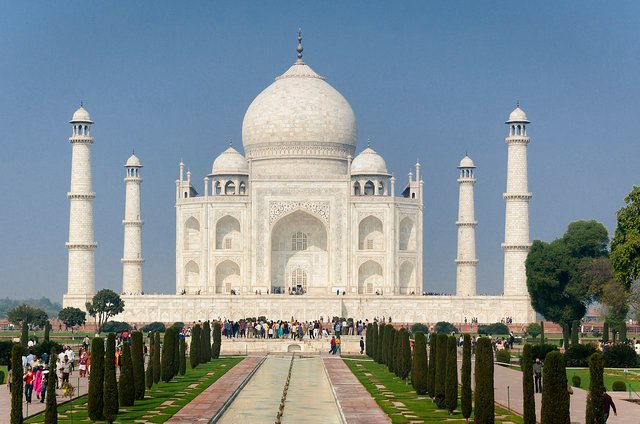The Taj Mahal lit. 'Crown of the Palace' is an ivory-white marble mausoleum on the right bank of the river Yamuna in the Indian city of Agra. It was commissioned in 1632 by the Mughal emperor Shah Jahan (r. 1628–1658) to house the tomb of his favorite wife, Mumtaz Mahal; it also houses the tomb of Shah Jahan himself. The tomb is the centerpiece of a 17-hectare (42-acre) complex, which includes a mosque and a guest house, and is set in formal gardens bounded on three sides by a crenelated wall.

Construction of the mausoleum was essentially completed in 1643, but work continued on other phases of the project for another 10 years. The Taj Mahal complex is believed to have been completed in its entirety in 1653 at a cost estimated at the time to be around ₹32 million, which in 2020 would be approximately ₹70 billion (about U.S. $1 billion). The construction project employed some 20,000 artisans under the guidance of a board of architects led by the court architect to the emperor, Ustad Ahmad Lahara. Various types of symbolism have been employed in the Taj to reflect natural beauty and divinity.
The Taj Mahal was designated as a UNESCO World Heritage Site in 1983 for being "the jewel of Muslim art in India and one of the universally admired masterpieces of the world's heritage". It is regarded by many as the best example of Mughal architecture and a symbol of India's rich history. The Taj Mahal attracts more than 6 million visitors a year and in 2007, it was declared a winner of the New 7 Wonders of the World (2000–2007) initiative.
Etymology
Abdul Hamid Lahauri, in his book from 1636 Padshahnama, refers to the Taj Mahal as rauza-i munawwara (Perso-Arabic: روضه منوره, rawdah-i munawwarah), meaning the illumined or illustrious tomb.The current name for the Taj Mahal is believed to be derived from the Persian تاج محل tāj Mahall, meaning "crown" (tāj) "palace" (mahall).The name "Taj" came from the corruption of the second syllabus of "Mumtaz".
Inspiration
The Taj Mahal was commissioned by Shah Jahan in 1631, to be built in the memory of his wife Mumtaz Mahal, who died on 17 June that year, while giving birth to their 14th child, Gauhara Begum.Construction started in 1632, and the mausoleum was completed in 1648, while the surrounding buildings and garden were finished five years later. The imperial court documenting Shah Jahan's grief after the death of Mumtaz Mahal illustrates the love story held as the inspiration for the Taj Mahal.
Nice
Downvoting a post can decrease pending rewards and make it less visible. Common reasons:
Submit
thnx
Downvoting a post can decrease pending rewards and make it less visible. Common reasons:
Submit
nice
Downvoting a post can decrease pending rewards and make it less visible. Common reasons:
Submit
thnx
Downvoting a post can decrease pending rewards and make it less visible. Common reasons:
Submit